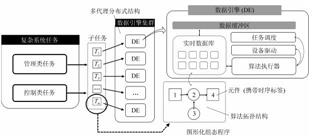| 平行系统方法在自动化集装箱码头中的应用研究 |
| |
| 引用本文: | 郑松, 吴晓林, 王飞跃, 林东东, 郑蓉, 柯伟林, 池新栋, 陈德旺. 平行系统方法在自动化集装箱码头中的应用研究. 自动化学报, 2019, 45(3): 490-504. doi: 10.16383/j.aas.c170734 |
| |
| 作者姓名: | 郑松 吴晓林 王飞跃 林东东 郑蓉 柯伟林 池新栋 陈德旺 |
| |
| 作者单位: | 1.福州大学电气工程与自动化学院 福州 350116;;2.工业自动化控制技术与信息处理福建省高校重点实验室 福州 350116;;3.爱普 (福建) 科技有限公司 福州 350116;;4.中国科学院自动化研究所复杂系统管理与控制国家重点实验室 北京 100190;;5.福州大学数学与计算机学院 福州 350116 |
| |
| 摘 要: | 
平行系统是一种建立在人工社会和计算实验基础上的科学研究方法,它的特点是既能真实反映现实系统的动态过程,又能实时优化现实系统的控制过程.自动化集装箱码头是一类典型的复杂系统,既存在不计其数的作业方案,同时也有大量的约束条件.如何在最短时间和最低能源消耗的前提下,完成具有间歇和批次特征的集装箱转运任务,是涉及到数学、控制、管理和计算机等多个学科的重大课题.本文采用数据引擎作为人工社会中的基本计算单元,构成一个复杂的平行系统,用于自动化集装箱码头信息控制系统的研究.
数据引擎作为一种面向图形化元件组态的计算环境,非常适用于复杂系统的建模与计算.在可视化和动态重构技术的支持下,利用380个数据引擎对一个具有8台岸桥、25辆AGV和16台龙门吊组成的港机系统进行了自动化作业过程的计算实验.研究结果表明,数据引擎技术是实现平行系统的有效方法,由多数据引擎组成的计算环境,能够大幅度降低自动化集装箱码头信息控制系统建模的复杂程度,能够将码头系统的管理和控制过程无缝地融合在一起.该平行系统可直接与港机设备对接,建立“人工码头”和“物理码头”之间的平行关系,从而实现对港机设备的最优控制.

|
| 关 键 词: | 平行系统 自动化码头 数据引擎 复杂系统 多代理 |
| 收稿时间: | 2017-12-28 |
|
| 点击此处可从《自动化学报》浏览原始摘要信息 |
|
点击此处可从《自动化学报》下载免费的PDF全文 |
|



